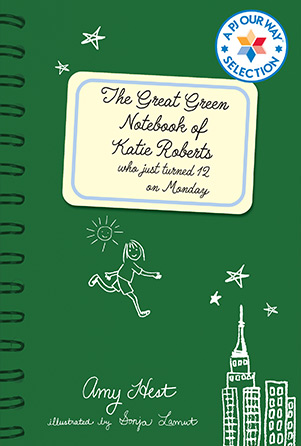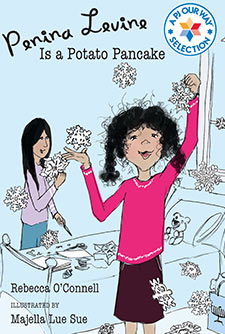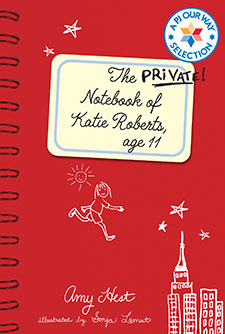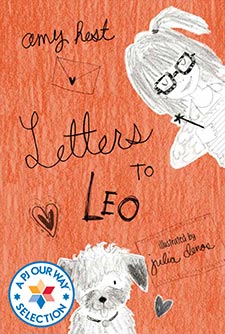The Great Green Notebook of Katie Roberts
Katie has a new notebook, and just in time, because she has lots to write about! Her mom only pays attention to her baby brothers and she won’t let Katie wear lipstick to school even though she’s 12! Could things get any worse? They sure can!
Average Rating
( hint: Login to leave a review! )
218 Reviews
Leave Review
What the Book is About
Jewish Content & Values
Positive Role Models
Content Advisory
Talk it Over!
More for You
What the Book is About
In this stand-alone sequel to The Private Notebook of Katie Roberts, Katie has entered seventh grade, and things aren't running smoothly at home. Her mother pays more attention to her twin baby brothers than to Katie, and she won’t let Katie wear lipstick to school. Plus, Katie’s stepfather, Sam, has bought a restaurant and is struggling to make ends meet. If that’s not bad enough, Katie is forced to tutor the annoying new boy in class, who came from Italy to live with his grandfather after his parents died in World War II. Set in 1948-9, Katie’s fresh voice and the fun diary format – complete with cute drawings – make this a great, kid-friendly choice.
Jewish Content & Values
- Katie's mother explains in general terms about the Holocaust.
- Katie goes to Hebrew school.
- Jewish holidays are celebrated, including Yom Kippur and Passover.
- Mrs. Leitstein and Mr. Pergolizzi have a Jewish wedding under a chuppah (a wedding canopy).
Positive Role Models
- Mrs. Leitstein was Katie’s friend and neighbor in New York. She gave Katie her notebooks, remains Katie’s confidante, and is not judgmental even when Katie has behaved badly. She comes out to Texas to help the family when Katie’s mother is in the hospital.
- Katie is sometimes unkind and selfish, but she learns from and apologizes for her mistakes.
Content Advisory
Rudy’s parents, grandmother, and little sister are killed in the war. The word “Holocaust” isn’t used, but Katie’s mother explains it to her in age appropriate terms, saying, “So many Jewish people died in Europe in the war, just for being Jewish.”
Talk it Over!
Katie tells Mrs Leitstein that Rudy should play baseball and act like the other boys in order to have friends. Would you follow the crowd to have friends, or would you only follow the crowd if people were doing something you wanted to do? What if they were doing something wrong? Do you think Katie is right suggesting that a person has to follow the crowd to have friends?
More for You
Rudy Pergolizzi and his family are Italian Jews. The Jews of Italy can be traced back to the second century BC. They were mainly based in southern Italy and spoke Greek. Italy was the main early center of Jewish printing, so Italian Jews were able to preserve a slightly different form of worship than Ashkenazi Jews from Eastern Europe or Sephardi Jews originating in Spain and Portugal. The Jews in the far south of Italy had closer ties to their fellow Jews in Greece and what is now Istanbul than to those in northern Italy. Today, there is a functioning Jewish quarter in Venice that dates back to the 16th century, and there are remnants of ghettos in Rome, Trieste, and Syracuse in Sicily, where the oldest mikveh (ritual bath) in Europe was discovered in 1989. It dates from the sixth century and is still in use by women who come from other parts of Italy to use it before they get married. The current Jewish population of Italy is around 25,000.
What the Book is About
What the Book is About
In this stand-alone sequel to The Private Notebook of Katie Roberts, Katie has entered seventh grade, and things aren't running smoothly at home. Her mother pays more attention to her twin baby brothers than to Katie, and she won’t let Katie wear lipstick to school. Plus, Katie’s stepfather, Sam, has bought a restaurant and is struggling to make ends meet. If that’s not bad enough, Katie is forced to tutor the annoying new boy in class, who came from Italy to live with his grandfather after his parents died in World War II. Set in 1948-9, Katie’s fresh voice and the fun diary format – complete with cute drawings – make this a great, kid-friendly choice.
Jewish Content & Values
Jewish Content & Values
- Katie's mother explains in general terms about the Holocaust.
- Katie goes to Hebrew school.
- Jewish holidays are celebrated, including Yom Kippur and Passover.
- Mrs. Leitstein and Mr. Pergolizzi have a Jewish wedding under a chuppah (a wedding canopy).
Positive Role Models
Positive Role Models
- Mrs. Leitstein was Katie’s friend and neighbor in New York. She gave Katie her notebooks, remains Katie’s confidante, and is not judgmental even when Katie has behaved badly. She comes out to Texas to help the family when Katie’s mother is in the hospital.
- Katie is sometimes unkind and selfish, but she learns from and apologizes for her mistakes.
Content Advisory
Content Advisory
Rudy’s parents, grandmother, and little sister are killed in the war. The word “Holocaust” isn’t used, but Katie’s mother explains it to her in age appropriate terms, saying, “So many Jewish people died in Europe in the war, just for being Jewish.”
Talk it Over!
Talk it Over!
Katie tells Mrs Leitstein that Rudy should play baseball and act like the other boys in order to have friends. Would you follow the crowd to have friends, or would you only follow the crowd if people were doing something you wanted to do? What if they were doing something wrong? Do you think Katie is right suggesting that a person has to follow the crowd to have friends?
More for You
More for You
Rudy Pergolizzi and his family are Italian Jews. The Jews of Italy can be traced back to the second century BC. They were mainly based in southern Italy and spoke Greek. Italy was the main early center of Jewish printing, so Italian Jews were able to preserve a slightly different form of worship than Ashkenazi Jews from Eastern Europe or Sephardi Jews originating in Spain and Portugal. The Jews in the far south of Italy had closer ties to their fellow Jews in Greece and what is now Istanbul than to those in northern Italy. Today, there is a functioning Jewish quarter in Venice that dates back to the 16th century, and there are remnants of ghettos in Rome, Trieste, and Syracuse in Sicily, where the oldest mikveh (ritual bath) in Europe was discovered in 1989. It dates from the sixth century and is still in use by women who come from other parts of Italy to use it before they get married. The current Jewish population of Italy is around 25,000.




